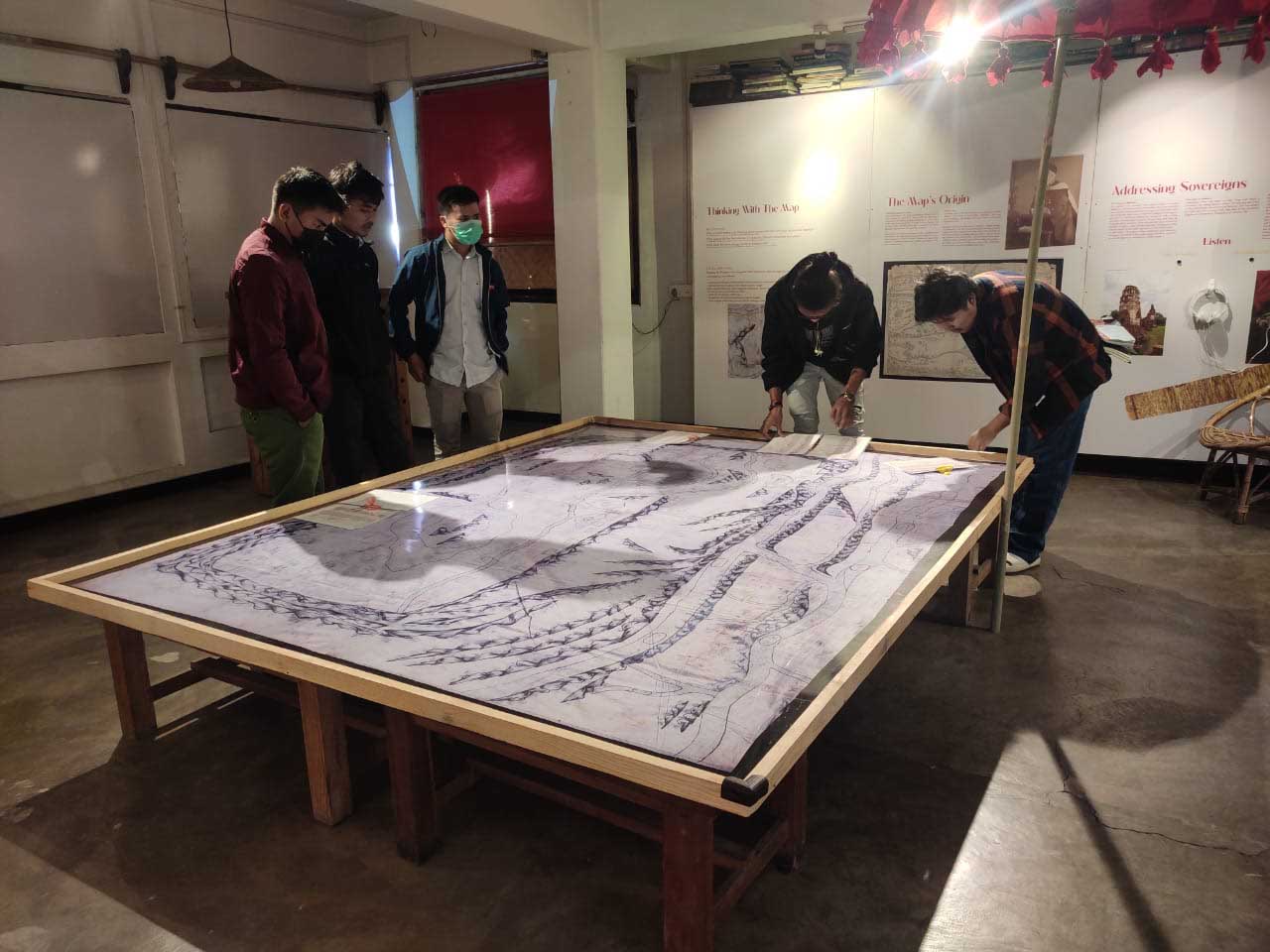An exhibition of Manipuri Map that reflected pre-seven years devastation period of Manipur or first devastation of Manipur attracts many visitors and served it as a moment to recall and trace back the forgotten part of Manipuri history.
The seven days long exhibition named as “Manipur and The Wrath of Alaungpaya” showcased the replica of military map used by Burmese King Alaungpaya, the founder of the Konbaung Dynasty. It was organised by a scholar of Cambridge University from London, Edward Moon-Little with his co-worker from Manipur Negi Thokchom under the sponsorship of King’s College London at auditorium of Book and Coffee Moirangkhom. This weeklong exhibition which concluded on February 4 has provided new historical information of Manipur little known before.
The map shows primarily the valley areas of Manipur in which as many as 200 places are identified. Manipur’s hill ranges are also indicated but no population centres are marked. It is believed that the map is a military map used by Alaungpaya during his 1758 and 1759 invasion of Manipur.
The interesting part of this military map is the use of three colour code yellow, blue and green. The yellow signifies the places which were overpowered by Burmese, while blue signifies places ruled by Meitei King and green code denotes places ruled by the Moirang principality.
While interacting with Edward Moon-Little, he said that the main objective of organising the exhibition is to let people know about this map which may be the “largest and oldest known map of Manipur”. The map was donated by G Yule in 1928 to Royal Geographical Society, London. The donor was a descendant of Scottish Orientalist Henry Yule, who wrote extensively about Anglo-Indians, Burma and North East India. The map depicts Burmese views of Manipur during 18th and 19th century.
He expressed his profound happiness on receiving good number of visitors stating that “we were supposed to conclude our exhibition on February 2 but it got extended till February 4 on public demand. Many young historians, academicians visiting the exhibition really makes me happy. I feel that my target to spread some historical information of Manipur is achieved to some extent.”
Seeing the exhibition one can reimagine the historical relation between Manipur and Burma. In the 1740s, a pivotal event took place in the relationship between Manipur and Burma. The chaplain of Garibniwaz arranged a marriage between Emperor Maha Dharma Raza Dipati and Shija Seityamala, a Meitei princess and niece of Garibniwaz. This union was intended to solidify the alliance between the two regions, as recorded in the Court Chronicle of Burma, quoted by Burmese historian Tun Aung Chain in his book ‘Broken Glass: Pieces of Myanmar History’ (2004), ‘the two Gold Plates became as one.’
On December 8, 1749, Garibniwaz himself escorted Seityamala to the emperor’s court, where she was given the title of Maha Dewi (Awa Reima). After the fall of the Toungoo dynasty of Burma, Seityamala again became the queen, this time to King Binnya Dala of the Restored Kingdom of Hanthawaddy of Lower Burma, where she was known as Thirizeyamingaladewi.
From March 22nd, 1752 to December 29th, 1756, she reigned as Queen of the Restored Hanthawaddy as recorded in Konbaungzet Mahayazawindawgyi (Chronicle of the Konbaung Dynasty). However, with the defeat of Hanthawaddy by Alungpaya, the founder of the last dynasty of Burma, the Konbaung, Seityamala once again became the Queen Mahadewi, this time for the third time, for the unified Burma. This was a remarkable feat for a woman of her time, and her story serves as an important reminder of the power of diplomacy and alliance-building in shaping the political landscape of Southeast Asia.
The Burmese royal chronicles of the 18th century provides a unique perspective on the 1758 campaign in Manipur. According to these historical accounts, Alaungpaya, the founder of the Konbaung dynasty, saw it as his duty to intervene in the affairs of Manipur, the homeland of his wife, Maha Devi. The chronicles present Alaungpaya’s decision to install a new king in Manipur and offer his protection as an act of devotion to his wife and her heritage.
In 1758, during the reign of King Gourshyam of Manipur, the fledgling Konbaung dynasty of Burma, under the leadership of its founder Alaungpaya, launched its first invasion of the kingdom. At this time, the crown prince of Manipur was Bhagyachandra. The Meckley empire, founded by their grandfather, was in a state of decline due to the murder of Garibniwaz on the banks of the Ningthee river by their uncle Ajit Shah.
The palace intrigue of their uncles, including their maternal uncle Khelemba, the prince of Moirang principality, who bestowed his daughter Princess Sajamni upon a Burmese emperor as a symbol of alliance, further destabilized the kingdom.
The Burmese invasion of 1758-59 was a result of these political machinations, marking a significant moment in the history of Manipur. The initial invasion of Manipur in 1759 marked a dark chapter in the history of the kingdom and is remembered as the “First Devastation.”
As a consequence of this invasion, the First Anglo-Manipuri Treaty was signed on September 14, 1762. According to the treaty map tabulated by William Lee-Warner in his book ‘The Protected Princes of India (1894),’ Manipur ranked sixth among the leading kingdoms in the Indian subcontinent that entered into a treaty with the East India Company.
The nature of the treaty was a defensive alliance against the Burmese, and it was signed by Agent Haridas Gossein on behalf of the King of Meckley and Harry Verelst, chief of the Chittagong factory, on behalf of the East India Company, Lee-Warner’s book says.
According to the Court Chronicle of Manipur Cheitharol Kumbaba, over the course of 17 years, from 1759 to 1776, the Burmese Empire launched six additional invasions, culminating in the infamous “Seven Years Devastation” of 1819. According to the account of an embassy to the Kingdom of Ava in 1795, Michael Symes quotes that these invasions resulted in the enslavement and displacement of thousands of Meiteis, who were settled in Burma and assimilated into various facets of Burmese society, including farming, weaving, military service, and even religious leadership.
According to Hiroko Kawanami in her book ‘Renunciation and Empowerment of Buddhist Nuns in Myanmar’ (2013), two notable examples of Manipuris taken as captives during this time are Me Kin and Me Natpei, who went on to become the first Buddhist nun teachers in modern Burma.
The Fall of Meckley was a significant event in the history of Manipur. It marked the end of an era and the beginning of a new one, characterized by political instability and intense power struggles. In a span of 77 years, princes were engaged in fierce battles, both amongst themselves and against the Burmese Empire. These struggles lasted for 75 years, as the princes sought to secure the throne in accordance with the political doctrines that had been adopted from Arthasastra and Hinduism, blended with the ancient Meitei combat principle of Chainarol.
The war finally came to an end when Manipuri princes Gambhir Singh, Narasingh and their Levy liberated Manipur from the Burmese empire and formed an alliance with the British East India Company, leading to the modernization of the kingdom.
This marked the merging of the old Meiteileibak, Garibniwaz’s Meckley, and the forces of modernity, painting the kingdom of Manipur on the canvas of 19th century history as an abstract form of its past, present, and future. This was a turning point in the history of Manipur, as the kingdom underwent significant changes, paving the way for its future as a modern state.
One of the visitors at the exhibition Wangam Somorjit told to IRAP that “As a visitor to the exhibition, we are presented with a glimpse into the forgotten war that took place in the heart of mainland Southeast Asia in the 18th century. Through the depictions on display, we are able to understand the relationship between the two prominent kingdoms of the region, as well as the impact that these conflicts had on the formation of modern-day Manipur. The exhibition provides a unique opportunity for us to delve into a piece of history that has been marginalized over time, reminding us of the rich cultural heritage that lies at the core of Southeast Asia.”










